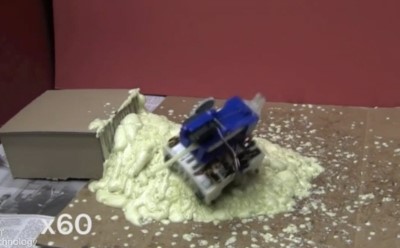다루기 힘든 예측 불가능한 자재로 건설하는 로봇 Team Designs Robots to Build Things in Messy, Unpredictable Situations(VIDEO)
재난 구조용으로 설계
VIDEO
http://www.technologyreview.com/news/540156/team-designs-robots-to-build-things-in-messy-unpredictable-situations/
edited by kcontents
케이콘텐츠 편집
연구자들이 발포 고무나 모래주머니와 같은 가변성 건축 자재를 이용하여 구조물을 만들 수 있는 간단한 로봇을 개발하였다. 미국의 하버드 대(Harvard University)와 뉴욕 주립 대 버펄로 캠퍼스(State University of New York at Buffalo)의 연구자들이 창고나 공장처럼 이상적이고 예측 가능한 환경을 벗어나서 기능을 수행하는 로봇을 설계하고 있다. 이 건설용 로봇은 예상치 않은 장애물이 존재할 수 있고, 예측 알고리즘을 수천 단계를 앞서서 계획하는 데에 사용할 수 없는 장소에서 작업을 수행할 것이다. 변덕스럽고 늘어나기 쉬운 건설 자재를 다루도록 설계된 이러한 건설 로봇의 목표는 재난 구조용 로봇으로 배치되는 것이다. 하버드 대에서 컴퓨터 과학 전공의 라드히카 나그팔(Radhika Nagpal) 교수, 뉴욕 주립 대 버펄로 캠퍼스에서 컴퓨터 과학 전공의 닐스 나프(Nils Napp) 부교수, 라드히카 나그팔 교수의 연구실에서 박사 후 과정이었던 한 연구원 등으로 구성된 연구팀은 2대의 로봇을 설계하였다. 하나의 로봇은 팽창할 수 있지만 자체 경화가 되는 발포 고무를 설치하고, 나머지 하나의 로봇은 모래주머니를 끌어서 쌓는다.
종래의 건설용 로봇은 통상적으로 블록이나 벽돌처럼 따로따로 된 자재만을 다룰 수 있다. 이번에 개발된 새로운 로봇이 다루게 되는 자재들은 다양한 실제의 환경에서 유용하지만, 예측가능성이 매우 낮다. 발포 고무는 다양한 표면에 붙을 수 있고 구멍을 메우도록 팽창될 수 있지만, 처음에 액체 물질로 출발하므로 경화되기 전에 얼마나 멀리 나아갈지를 정확하게 아는 것이 불가능하다. 모래주머니는 재난 구조 작업에서 옹벽으로 자주 사용되지만, 모래주머니 내부에 있은 작은 알갱이들은 조작될 때 이리저리 이동하는 경향이 있다. 이러한 예측 불가능성을 다루기 위하여 라드히카 나그팔 교수와 닐스 나프 부교수가 개발한 로봇들은 건축 자재를 내려놓는 동안에 환경을 스캔하고 평가하는 적외선 센서를 갖추고 있다. 이러한 스캔 동작은 로봇이 높은 적응성을 가지도록 하는 데에 있어 필수불가결하다. “이러한 로봇들은 작업을 하는 동안에 지속적으로 환경을 감시하고 계획을 다시 세울 필요가 있다. 이것은 자연에서 존재하는 동물들이 하는 중요한 일이나, 종종 로봇은 이를 수행하지 않는다”고 닐스 나프 부교수가 말했다. 로봇은 스캔하기, 환경 평가하기, 자재 쌓기, 스캔 다시 하기, 환경 변화 평가하기, 더 많은 자재 쌓기 등과 같이 순환 방식으로 기능을 하는 알고리즘을 이용하여 이동하면서 건설용 자재의 변화뿐만 아니라 환경에서 임의의 변화를 고려하여 되풀이하여 작업을 수행할 수 있다. 연구팀은 현재 높은 적응성을 가지는 이 시스템을 경사로를 만드는 데에 집중적으로 활용하고 있다. 경사로는 두 지점을 연결하는 데 사용될 수 있고 설계 상 많은 유연성을 가지는 비교적 간단한 구조물로, 실용적으로 다수의 응용성을 가진다. 이 시스템은 발포 고무나 모래주머니뿐만 아니라 예측할 수 없는 임의의 자재를 이용하는 모든 등반용 로봇 혹은 조작용 로봇에 적용될 수 있다. 또한, 라드히카 나그팔 교수는 이 시스템이 여러 로봇들이 협력하여 임무를 수행하는 다중 로봇팀에도 적용될 수 있다고 말한다. 이 알고리즘은 높은 적응성을 가지므로 로봇이 직면하는 불확실성의 원인이 환경에서 오든지, 자재로부터 오든지, 아니면 또 다른 로봇의 행동에 의해서 발생하는지 여부는 문제가 되지 않는다. 연구자들은 이제 막 이 시스템을 불확실성이 점점 증가하는 환경에서 시험하기 시작했다. 다음 단계는 어떠한 자재가 가용한지를 알지 못하는 상황에서 건설용 로봇을 구현하는 것이 될 것이다. 출처 KISTI 미리안 『글로벌동향브리핑』 |
Team Designs Robots to Build Things in Messy, Unpredictable Situations
Researchers have developed simple robots that can build structures with malleable materials such as foam and sandbags.
By Julia Sklar on August 20, 2015
Why It MattersRobots are often limited because they can’t handle malleable materials or work in unpredictable environments.
One of Nagpal and Napp’s robots has no top or bottom. It can keep working even after falling and flipping over.
Researchers at Harvard University and SUNY at Buffalo are designing robots to function outside of ideal, predictable environments such as warehouses or factories and instead work in places where there may be unexpected obstructions, and where predictive algorithms can’t be used to plan several thousand steps ahead. The goal for such “builder bots,” which are designed to handle inconsistent and malleable building materials, is to be deployed as disaster relief agents.
Radhika Nagpal, professor of computer science at Harvard, and Nils Napp, an assistant professor of computer science at SUNY at Buffalo and a former post-doctoral fellow in Nagpal’s lab, have designed two robots: one that deposits expandable, self-hardening foam and another that drags and piles up sandbags.
Robots built for construction can usually handle only discrete materials, such as blocks or bricks. The materials these new robots build with are useful in a range of real-world environments, but they are highly unpredictable. The foam can stick to most surfaces and expand to fill holes, but it starts off as a liquid, so it’s impossible to know exactly how far it’ll run before it hardens; sandbags are frequently used in disaster relief as retaining walls, but the granules inside sandbags have a tendency to shift around when manipulated.
To combat this unpredictability, Nagpal and Napp’s robots are equipped with an infrared sensor that takes scans and assesses the environment in between laying down a building material. The scan is integral to making the bots so adaptable.
“These robots need to continuously monitor and replan while they work,” says Napp. “That’s something that animals do, and that robots often don’t do.”
Using an algorithm that functions as a loop—scan, assess the environment, lay the material, scan again, assess the changes to the environment, lay more material, etc.—the robots are able to iteratively build as they go, taking into account any changes in the environment, as well as any changes to the material with which they’re building.
The team is currently focusing this adaptable system on building ramps, a relatively simple structure with practical applications: they can be used to connect two points, and also have a lot of flexibility in design.
The system is applicable for any climbing, manipulating robot that’s using any unpredictable materials, not just foam or sandbags. Nagpal also says that the system can work with multi-robot teams. Because the algorithm is adaptable, it doesn’t matter whether the uncertainty that a robot confronts comes from the environment, a material, or from another robot’s behavior.
The researchers are just starting to test out the system in increasingly unpredictable environments. The next stage will be to configure a robot to build in situations where it doesn’t know what materials will be available.
케이콘텐츠
kcontents
"from past to future"
데일리건설뉴스 construction news
콘페이퍼 conpaper
.










